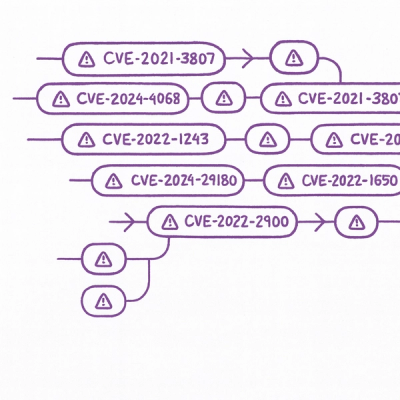
Security News
New Website “Is It Really FOSS?” Tracks Transparency in Open Source Distribution Models
A new site reviews software projects to reveal if they’re truly FOSS, making complex licensing and distribution models easy to understand.
actionpack-rack-upgrade
Advanced tools
= Action Pack -- On rails from request to response
Action Pack splits the response to a web request into a controller part (performing the logic) and a view part (rendering a template). This two-step approach is known as an action, which will normally create, read, update, or delete (CRUD for short) some sort of model part (often backed by a database) before choosing either to render a template or redirecting to another action.
Action Pack implements these actions as public methods on Action Controllers and uses Action Views to implement the template rendering. Action Controllers are then responsible for handling all the actions relating to a certain part of an application. This grouping usually consists of actions for lists and for CRUDs revolving around a single (or a few) model objects. So ContactsController would be responsible for listing contacts, creating, deleting, and updating contacts. A WeblogController could be responsible for both posts and comments.
Action View templates are written using embedded Ruby in tags mingled in with the HTML. To avoid cluttering the templates with code, a bunch of helper classes provide common behavior for forms, dates, and strings. And it's easy to add specific helpers to keep the separation as the application evolves.
Note: Some of the features, such as scaffolding and form building, are tied to ActiveRecord[http://activerecord.rubyonrails.org] (an object-relational mapping package), but that doesn't mean that Action Pack depends on Active Record. Action Pack is an independent package that can be used with any sort of backend (Instiki[http://www.instiki.org], which is based on an older version of Action Pack, used Madeleine for example). Read more about the role Action Pack can play when used together with Active Record on http://www.rubyonrails.org.
A short rundown of the major features:
Actions grouped in controller as methods instead of separate command objects and can therefore share helper methods
CustomersController < ActionController::Base def show @customer = find_customer end
def update
@customer = find_customer
@customer.attributes = params[:customer]
@customer.save ?
redirect_to(:action => "show") :
render(:action => "edit")
end
private
def find_customer() Customer.find(params[:id]) end
end
{Learn more}[link:classes/ActionController/Base.html]
Embedded Ruby for templates (no new "easy" template language)
<% for post in @posts %> Title: <%= post.title %> <% end %>
All post titles: <%= @posts.collect{ |p| p.title }.join ", " %>
<% unless @person.is_client? %> Not for clients to see... <% end %>
{Learn more}[link:classes/ActionView.html]
Builder-based templates (great for XML content, like RSS)
xml.rss("version" => "2.0") do xml.channel do xml.title(@feed_title) xml.link(@url) xml.description "Basecamp: Recent items" xml.language "en-us" xml.ttl "40"
for item in @recent_items
xml.item do
xml.title(item_title(item))
xml.description(item_description(item))
xml.pubDate(item_pubDate(item))
xml.guid(@recent_items.url(item))
xml.link(@recent_items.url(item))
end
end
end
end
{Learn more}[link:classes/ActionView/Base.html]
Filters for pre and post processing of the response (as methods, procs, and classes)
class WeblogController < ActionController::Base before_filter :authenticate, :cache, :audit after_filter { |c| c.response.body = Gzip::compress(c.response.body) } after_filter LocalizeFilter
def index
# Before this action is run, the user will be authenticated, the cache
# will be examined to see if a valid copy of the results already
# exists, and the action will be logged for auditing.
# After this action has run, the output will first be localized then
# compressed to minimize bandwidth usage
end
private
def authenticate
# Implement the filter with full access to both request and response
end
end
{Learn more}[link:classes/ActionController/Filters/ClassMethods.html]
Helpers for forms, dates, action links, and text
<%= text_field "post", "title", "size" => 30 %> <%= html_date_select(Date.today) %> <%= link_to "New post", :controller => "post", :action => "new" %> <%= truncate(post.title, :length => 25) %>
{Learn more}[link:classes/ActionView/Helpers.html]
Layout sharing for template reuse (think simple version of Struts Tiles[http://jakarta.apache.org/struts/userGuide/dev_tiles.html])
class WeblogController < ActionController::Base layout "weblog_layout"
def hello_world
end
end
Layout file (called weblog_layout): <%= yield %>
Template for hello_world action:
Result of running hello_world action:
{Learn more}[link:classes/ActionController/Layout/ClassMethods.html]
Routing makes pretty urls incredibly easy
map.connect 'clients/:client_name/:project_name/:controller/:action'
Accessing /clients/37signals/basecamp/project/dash calls ProjectController#dash with { "client_name" => "37signals", "project_name" => "basecamp" }.
From that URL you can redirect providing new parameters in a number of ways:
redirect_to :action => "edit"
redirect_to :client_name => "nextangle", :project_name => "rails"
{Learn more}[link:classes/ActionController/Base.html]
JavaScript and Ajax integration
link_to_function "Greeting", "alert('Hello world!')" link_to_remote "Delete this post", :update => "posts", :url => { :action => "destroy", :id => post.id }
{Learn more}[link:classes/ActionView/Helpers/JavaScriptHelper.html]
Easy testing of both controller and rendered template through ActionController::TestCase
class LoginControllerTest < ActionController::TestCase def test_failing_authenticate process :authenticate, :user_name => "nop", :password => "" assert flash.has_key?(:alert) assert_redirected_to :action => "index" end end
{Learn more}[link:classes/ActionController/TestCase.html]
Automated benchmarking and integrated logging
Processing WeblogController#index (for 127.0.0.1 at Fri May 28 00:41:55) Parameters: {"action"=>"index", "controller"=>"weblog"} Rendering weblog/index (200 OK) Completed in 0.029281 (34 reqs/sec)
If Active Record is used as the model, you'll have the database debugging as well:
Processing PostsController#create (for 127.0.0.1 at Sat Jun 19 14:04:23) Params: {"controller"=>"posts", "action"=>"create", "post"=>{"title"=>"this is good"} } SQL (0.000627) INSERT INTO posts (title) VALUES('this is good') Redirected to http://example.com/posts/5 Completed in 0.221764 (4 reqs/sec) | DB: 0.059920 (27%)
You specify a logger through a class method, such as:
ActionController::Base.logger = Logger.new("Application Log") ActionController::Base.logger = Log4r::Logger.new("Application Log")
Caching at three levels of granularity (page, action, fragment)
class WeblogController < ActionController::Base caches_page :show caches_action :account
def show
# the output of the method will be cached as
# ActionController::Base.page_cache_directory + "/weblog/show/n.html"
# and the web server will pick it up without even hitting Rails
end
def account
# the output of the method will be cached in the fragment store
# but Rails is hit to retrieve it, so filters are run
end
def update
List.update(params[:list][:id], params[:list])
expire_page :action => "show", :id => params[:list][:id]
expire_action :action => "account"
redirect_to :action => "show", :id => params[:list][:id]
end
end
{Learn more}[link:classes/ActionController/Caching.html]
Powerful debugging mechanism for local requests
All exceptions raised on actions performed on the request of a local user will be presented with a tailored debugging screen that includes exception message, stack trace, request parameters, session contents, and the half-finished response.
{Learn more}[link:classes/ActionController/Rescue.html]
Scaffolding for Active Record model objects
class AccountController < ActionController::Base scaffold :account end
The AccountController now has the full CRUD range of actions and default templates: list, show, destroy, new, create, edit, update
{Learn more}[link:classes/ActionController/Scaffolding/ClassMethods.html]
Form building for Active Record model objects
The post object has a title (varchar), content (text), and written_on (date)
<%= form "post" %>
...will generate something like (the selects will have more options, of course):
Title:
Content:
<%= @post.title %>
Written on:
18
July
2004
<input type="submit" value="Create">
This form generates a params[:post] array that can be used directly in a save action:
class WeblogController < ActionController::Base def create post = Post.create(params[:post]) redirect_to :action => "show", :id => post.id end end
{Learn more}[link:classes/ActionView/Helpers/ActiveRecordHelper.html]
Runs on top of WEBrick, Mongrel, CGI, FCGI, and mod_ruby
== Simple example (from outside of Rails)
This example will implement a simple weblog system using inline templates and an Active Record model. So let's build that WeblogController with just a few methods:
require 'action_controller' require 'post'
class WeblogController < ActionController::Base layout "weblog/layout"
def index
@posts = Post.find(:all)
end
def show
@post = Post.find(params[:id])
end
def new
@post = Post.new
end
def create
@post = Post.create(params[:post])
redirect_to :action => "show", :id => @post.id
end
end
WeblogController::Base.view_paths = [ File.dirname(FILE) ] WeblogController.process_cgi if $0 == FILE
The last two lines are responsible for telling ActionController where the template files are located and actually running the controller on a new request from the web-server (like to be Apache).
And the templates look like this:
weblog/layout.html.erb: <%= yield %>
weblog/index.html.erb: <% for post in @posts %>
<%= link_to(post.title, :action => "show", :id => post.id) %>
<% end %>weblog/show.html.erb:
<%= @post.title %>
<%= @post.content %>
weblog/new.html.erb: <%= form "post" %>
This simple setup will list all the posts in the system on the index page, which is called by accessing /weblog/. It uses the form builder for the Active Record model to make the new screen, which in turn hands everything over to the create action (that's the default target for the form builder when given a new model). After creating the post, it'll redirect to the show page using an URL such as /weblog/5 (where 5 is the id of the post).
== Download
The latest version of Action Pack can be found at
Documentation can be found at
== Installation
You can install Action Pack with the following command.
% [sudo] ruby install.rb
from its distribution directory.
== License
Action Pack is released under the MIT license.
== Support
The Action Pack homepage is http://www.rubyonrails.org. You can find the Action Pack RubyForge page at http://rubyforge.org/projects/actionpack. And as Jim from Rake says:
Feel free to submit commits or feature requests. If you send a patch, remember to update the corresponding unit tests. If fact, I prefer new feature to be submitted in the form of new unit tests.
FAQs
Unknown package
We found that actionpack-rack-upgrade demonstrated a not healthy version release cadence and project activity because the last version was released a year ago. It has 1 open source maintainer collaborating on the project.
Did you know?

Socket for GitHub automatically highlights issues in each pull request and monitors the health of all your open source dependencies. Discover the contents of your packages and block harmful activity before you install or update your dependencies.

Security News
A new site reviews software projects to reveal if they’re truly FOSS, making complex licensing and distribution models easy to understand.

Security News
Astral unveils pyx, a Python-native package registry in beta, designed to speed installs, enhance security, and integrate deeply with uv.

Security News
The Latio podcast explores how static and runtime reachability help teams prioritize exploitable vulnerabilities and streamline AppSec workflows.